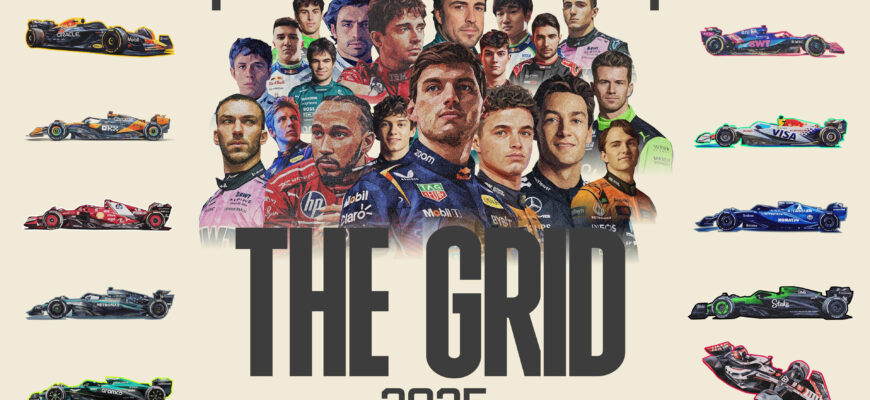As the checkered flag looms for Formula 1’s current technical regulations, the 2025 season promises to be a captivating blend of continuity, strategic shifts, and the most anticipated driver transfer in recent memory. This is not merely another year on the calendar; it`s a pivotal moment, a swansong for one era and a palpable prelude to the next.
A Global Odyssey with Strategic Nuances
The 2025 Formula 1 calendar will once again challenge teams and drivers with a sprawling 24-race schedule, maintaining the record-breaking intensity of its predecessor. However, the season`s opening acts are set for a notable shuffle, proving that even a familiar stage can host new choreography.
Gone is the immediate Middle Eastern double-header that has kicked off recent seasons. Instead, the engines will roar to life on March 16 in Melbourne, Australia, marking Albert Park`s return as the season opener for the first time since 2019. This change isn`t arbitrary; it`s a logistical ballet dictated by the observance of Ramadan in March, which sees the Bahrain and Saudi Arabian Grands Prix strategically relocated to April as the fourth and fifth rounds.
From the sun-drenched shores of Australia to the vibrant circuits of Asia, Europe, and the Americas, the season will traverse continents before culminating on December 7 in Abu Dhabi. This final race isn`t just a championship decider; it`s the official curtain call for the current generation of cars and power units, setting the stage for the dramatic technical overhaul slated for 2026.
Sprint Races: The Short-Form Thrill Continues
Love them or lament them, Sprint weekends are firmly ingrained in the F1 landscape, with six such events scheduled for 2025. These shorter, Saturday races continue to offer a unique strategic challenge and an extra dose of competitive action, adding another layer to the championship narrative.
The roster of Sprint venues sees a solitary, yet significant, change: Belgium`s iconic Spa-Francorchamps circuit will embrace the alternative format, replacing Austria. This means fans can anticipate Sprint action at:
- China
- Miami
- Austin (USA)
- Brazil
- Qatar
- Belgium
The addition of Spa to the Sprint lineup is particularly intriguing. Its notoriously long and undulating layout, often accompanied by unpredictable weather, could inject even more chaos and spectacle into the 100km dash. Drivers and strategists will need to be at their sharpest, balancing aggression for points with preservation for Sunday`s main event.
The Driver Market: A Seismic Shift and Musical Chairs
Perhaps the most electrifying aspect of the 2025 season lies within the driver lineup. The grid is set for a substantial shake-up, a veritable game of musical chairs that has left only two teams with an unchanged pairing from 2024. The implications are profound, promising fresh team dynamics, new rivalries, and a renewed sense of unpredictability.
Dominating headlines and igniting fervent discussion is the monumental transfer of seven-time world champion Lewis Hamilton to Ferrari. Described by some as “the biggest driver transfer of all time,” Hamilton`s switch from Mercedes to the Scuderia is a plot twist worthy of Hollywood. After an illustrious career synonymous with the Silver Arrows, seeing him in the iconic red promises an emotional and intensely competitive spectacle.
“For Lewis, it’s a career-defining leap; for Ferrari, it’s a gamble on a legend to break a long-standing championship drought. For the rest of us, it’s simply unmissable television.”
This move alone has cascaded through the driver market, opening up a coveted seat at Mercedes and causing a ripple effect across multiple teams. Drivers are jostling for position, contracts are being negotiated, and the future of several talents hangs in the balance. The competitive landscape will undoubtedly be altered, creating a season where individual performances and team pairings will be scrutinized like never before.
The Calm Before the Storm: Looking Towards 2026
While 2025 stands on its own as a fascinating season, it`s impossible to ignore the elephant in the paddock: the sweeping new technical regulations arriving in 2026. This makes 2025 a unique transitional year.
Teams face a complex strategic dilemma: should they continue aggressive development on the outgoing cars, aiming for a final flourish under current rules, or shift resources early to gain a crucial head start on the 2026 challengers? For some, 2025 might well be a sophisticated balancing act, a subtle dance between immediate performance and future dominance.
Pre-season testing, scheduled for February 26-28 in Bahrain, will offer the first glimpse of how these decisions might manifest on track. Before that, the F1 75 Live season launch event at The O2 on February 18 will undoubtedly set the tone, buzzing with anticipation for the season ahead.
Conclusion: A Season of High Stakes and High Drama
The 2025 Formula 1 season is poised to deliver exceptional drama, intrigue, and relentless competition. From a calendar that juggles global logistics to the high-stakes gamble of driver transfers, every element points towards a year where records might fall, legends might be forged, and the future shape of the sport will begin to crystallize.
Fasten your seatbelts; the final chapter of this F1 era promises to be a wild ride, and the prologue to the next has already begun.







